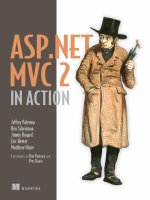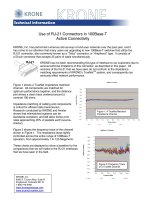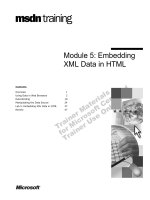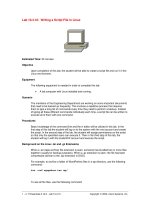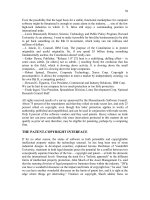ortlets in Action pptx
Bạn đang xem bản rút gọn của tài liệu. Xem và tải ngay bản đầy đủ của tài liệu tại đây (17.47 MB, 644 trang )
MANNING
Ashish Sarin
Covers Portlet 2.0, Spring 3.0 Portlet MVC,
WSRP 2.0, Portlet Bridges, Ajax, Comet,
Liferay, GateIn, Spring JDBC and Hibernate
IN ACTION
www.it-ebooks.info
BEST PRACTICES INSIDE THE BOOK
Best Practice Page number Section
Use user attributes to obtain user
information in portals 96 3.2.2
Handle portal server–specific
requests using
PortalContext
99 3.2.4
Encode URLs to resources 102 3.3.1
Choose appropriate portlet
lifecycle phase to process an action 107 3.3.4
Add custom JavaScript and CSS files
to a portal page using
MARKUP_HEAD
element 108 3.3.5
Choose appropriate
PortletSession
scope for storing objects 116 3.4.4
Evaluate use of container-runtime options 123 3.7.1
Use
actionScopedRequestAttributes
along with
PortletSession
127 3.7.1
Choose wisely when to use
servletDefaultSessionScope
container-runtime option 128 3.7.2
Consider performance impact of
container-runtime options 130 3.7.5
Choose appropriate validation token
in validation-based caching strategy 140 4.1.2
Localize portlet content 141 4.2
Use Apache Commons
FileUpload
for
uploading files 156 4.6.1
Override portlet request and response
objects’ functionality using wrapper classes 158 4.6.2
Design portable portlets 161 4.7
Simplify portlet URL creation using
portlet tag library tags 213 6.3
(Continued on inside back cover)
www.it-ebooks.info
Portlets in Action
www.it-ebooks.info
www.it-ebooks.info
Portlets in Action
ASHISH SARIN
MANNING
SHELTER ISLAND
www.it-ebooks.info
For online information and ordering of this and other Manning books, please visit
www.manning.com. The publisher offers discounts on this book when ordered in quantity.
For more information, please contact
Special Sales Department
Manning Publications Co.
20 Baldwin Road
PO Box 261
Shelter Island, NY 11964
Email:
©2012 by Manning Publications Co. All rights reserved.
No part of this publication may be reproduced, stored in a retrieval system, or transmitted, in
any form or by means electronic, mechanical, photocopying, or otherwise, without prior written
permission of the publisher.
Many of the designations used by manufacturers and sellers to distinguish their products are
claimed as trademarks. Where those designations appear in the book, and Manning
Publications was aware of a trademark claim, the designations have been printed in initial caps
or all caps.
Recognizing the importance of preserving what has been written, it is Manning’s policy to have
the books we publish printed on acid-free paper, and we exert our best efforts to that end.
Recognizing also our responsibility to conserve the resources of our planet, Manning books
are printed on paper that is at least 15 percent recycled and processed without the use of
elemental chlorine.
Manning Publications Co. Development editors: Emily Macel, Jeff Bleiel
20 Baldwin Road Copyeditor: Andy Carroll
PO Box 261 Proofreader: Katie Tennant
Shelter Island, NY 11964 Typesetter: Dennis Dalinnik
Cover designer: Marija Tudor
ISBN: 9781935182542
Printed in the United States of America
1 2 3 4 5 6 7 8 9 10 – MAL – 17 16 15 14 13 12 11
www.it-ebooks.info
v
brief contents
PART 1 GETTING STARTED WITH PORTLET DEVELOPMENT 1
1 ■ Introducing portals and portlets 3
2 ■ The portlet lifecycle 48
3 ■ Portlet 2.0 API—portlet objects and
container-runtime options 86
4 ■ Portlet 2.0 API—caching, security,
and localization 132
5 ■ Building your own portal 167
6 ■ Using the portlet tag library 207
PART 2 DEVELOPING PORTLETS USING SPRING
AND HIBERNATE 231
7 ■ Getting started with Spring Portlet MVC 233
8 ■ Annotation-driven development with Spring 281
9 ■ Integrating portlets with databases 334
www.it-ebooks.info
BRIEF CONTENTSvi
PART 3 ADVANCED PORTLET DEVELOPMENT 373
10 ■ Personalizing portlets 375
11 ■ Communicating with other portlets 405
12 ■ Ajaxing portlets 437
13 ■ Reusable logic with portlet filters 494
14 ■ Portlet bridges 510
15 ■ Web Services for Remote Portlets (WSRP) 533
www.it-ebooks.info
vii
contents
preface xix
acknowledgments xxi
about this book xxii
about the cover illustration xxvii
PART 1 GETTING STARTED WITH PORTLET
DEVELOPMENT 1
1
Introducing portals and portlets 3
1.1 What is a portal? 4
1.2 Benefits of web portals 6
Enriched user experience 6
■
Unified information view 9
1.3 What is a portlet? 10
1.4 Why use portlets? 12
Inter-portlet communication vs. inter-servlet
communication 12
■
Portlets vs. widgets 13
Creating mashups 15
1.5 Portal infrastructure 15
The portlet container 15
■
The portal server 16
www.it-ebooks.info
CONTENTS
viii
1.6 Getting started with Liferay Portal 18
Installing Liferay Portal 6.x 18
■
Registering users
with Liferay Portal 20
■
Creating a public portal page
in Liferay Portal 21
■
Adding portlets to a Liferay
Portal page 23
■
Roles and permissions in Liferay Portal 24
1.7 Setting up the development environment 26
Configuring Eclipse IDE 26
■
Setting up the project structure 34
1.8 The Hello World portlet example 35
Creating a Hello World portlet 35
■
Building the
Hello World project with Ant 39
■
Building the Hello World
project with Maven 42
■
Adding the Hello World portlet to
a portal page 43
■
Undeploying a portlet application 46
1.9 Summary 46
2
The portlet lifecycle 48
2.1 Requirements for the User Registration portlet 49
2.2 Portlets vs. servlets—an in-depth look 51
Portlet and servlet containers 51
■
Portlets—web
components with multiple request-processing phases 52
2.3 Portlet URLs 54
Portlet URLs vs. servlet URLs 54
■
Portlet URL types 56
2.4 Creating portlets 57
Creating portlets with the Portlet interface 57
■
Creating portlets
with the GenericPortlet class 60
2.5 Generating portlet content based on portlet mode 62
Writing content generation methods for each portlet mode 64
Defining support for portlet modes 67
2.6 Portlet development in depth 68
The Portlet API objects 69
■
Creating JSPs to display
portlet content 70
■
The portlet deployment descriptor 72
Dispatching portlet requests using the PortletRequestDispatcher 73
Internationalization and localization using resource bundles 75
Portlet initialization parameters 76
■
Creating portlet URLs 76
Container-runtime options 78
www.it-ebooks.info
CONTENTS
ix
2.7 Implementing the User Registration portlet 80
The UserRegistrationPortlet class 81
■
JSP pages 84
2.8 Summary 85
3
Portlet 2.0 API—portlet objects and
container-runtime options 86
3.1 Requirements for the Book Catalog portlet 87
3.2 Portlet request objects 92
Portlet request objects and lifecycle interfaces 92
■
PortletRequest
constants 94
■
PortletRequest methods 97
■
Handling portal
server–specific requests using PortalContext 99
3.3 Portlet response objects 100
Encoding URLs with the encodeURL method 102
■
Generating
content using RenderResponse 103
■
Responding to an action
using ActionResponse 104
■
Choosing an appropriate phase
for an action 107
■
Adding custom JavaScript and CSS
files to a portal page 108
3.4 Storing user-specific data in a portlet session 112
PortletSession object and methods 112
■
PortletSession usage
in the Book Catalog portlet 113
■
Obtaining session attributes
using PortletSessionUtil 114
■
An in-depth look at portlet
session scopes 116
■
Portlet session and content caching 118
Similarities between HttpSession and PortletSession 118
Sharing session data across portlet applications 119
3.5 Discovering the portlet environment using
PortletContext 119
3.6 Retrieving portlet configuration using PortletConfig 120
3.7 Container-runtime options 121
Using actionScopedRequestAttributes 123
■
Using
servletDefaultSessionScope 127
■
Using escapeXml 128
Using renderHeaders 130
■
Specifying Portlet and Portlet
application container-runtime options 130
3.8 Summary 131
www.it-ebooks.info
CONTENTS
x
4
Portlet 2.0 API—caching, security, and localization 132
4.1 Caching generated content 133
Expiration-based content caching 134
■
Validation-based
content caching 137
4.2 Localizing portlet content 141
Implementing portlets to support localization 142
Changing locales using built-in portlets 143
4.3 Portlet modes in depth 143
Custom portlet modes 144
■
Portal-managed and
portlet-managed portlet modes 148
■
Portlet modes
and markup types 150
4.4 Portlet window states in depth 151
Custom window states 152
■
Portlet window
states and markup types 153
4.5 Programmatic security 154
4.6 Uploading files, wrapping requests and responses, and
creating portlet URL generation listeners 156
Uploading files 156
■
Using wrapper classes 158
Using the PortletURLGenerationListener interface 159
4.7 Designing portable portlets 161
Portal server features and limitations 162
Designing for change 163
4.8 Summary 166
5
Building your own portal 167
5.1 Requirements for Book Portal 168
5.2 Getting started developing Book Portal 170
Creating an organization for Book Portal 171
Creating roles for Book Portal users 173
■
Mapping roles
to the Book Portal organization 174
■
Creating Book
Portal users and assigning them to the organization 175
Mapping users to roles 177
www.it-ebooks.info
CONTENTS
xi
5.3 Creating portal pages and adding portlets 178
Creating a Home portal page 178
■
Adding an
Announcements portlet 182
■
Adding an RSS feed portlet 184
Setting permissions for portal pages and portlets 185
Using the built-in Document Library and Book Catalog portlets
together 188
■
Setting permissions for displaying the
book catalog 191
■
Setting permissions for displaying
discussion forums 192
5.4 Configuring Liferay Portal server settings 193
Setting the authentication mechanism 194
■
Specifying the
default user associations 195
5.5 Developing with the Liferay Plugins SDK 196
Configuring the Plugins SDK 197
■
Developing
portal themes 198
■
Developing page layout templates 203
5.6 Summary 206
6
Using the portlet tag library 207
6.1 Using the tag library to build a Book Catalog portlet 208
6.2 Accessing portlet-specific objects using
<defineObjects> 210
Making portlet objects available with <defineObjects> 210
Using <defineObjects> in the Book Catalog portlet 212
6.3 Using <actionURL>, <renderURL>, and
<resourceURL> 213
Using the <actionURL> tag 213
■
Using the
<renderURL> tag 220
■
Using the <resourceURL> tag 220
6.4 Adding parameters to portlet URLs using <param> 221
Using the <param> tag 221
■
Adding parameters using
string concatenation 223
6.5 Creating portlet-specific HTML elements using
<namespace> 223
When to use the <namespace> tag 224
■
Obtaining form
field values in the portlet class 227
6.6 Adding properties to URLs using <property> 228
6.7 Summary 229
www.it-ebooks.info
CONTENTS
xii
PART 2 DEVELOPING PORTLETS USING SPRING
AND HIBERNATE 231
7
Getting started with Spring Portlet MVC 233
7.1 Why use Spring Portlet MVC? 234
7.2 Dependency injection and the application context 235
An e-commerce example 235
■
Dependency injection
and application contexts 237
■
Web application
contexts 240
7.3 A Hello World portlet, the Spring way 241
The Hello World portlet’s controller class 242
■
The Hello
World portlet’s JSP page 243
■
The Hello World portlet’s
portlet deployment descriptor 243
■
The Hello World portlet’s
web application context 244
■
The Hello World portlet’s web
application deployment descriptor 245
7.4 How Spring Portlet MVC works 246
7.5 Using DispatcherPortlet 248
7.6 Using the web application context 249
Naming web application context XML files 249
■
Scope of
beans defined in the web application context XML 250
7.7 Using built-in controllers 252
Using the Controller interface 253
Using the AbstractController 254
Using the ParameterizableViewController 256
Using the PortletModeNameViewController 257
Using the PortletWrappingController 259
7.8 Using built-in handler mappings 260
Developing a Book Catalog portlet with Spring Portlet MVC 262
Using PortletModeHandlerMapping 263
Using ParameterHandlerMapping 264
Using PortletModeParameterHandlerMapping 267
Using AbstractHandlerMapping 270
7.9 Using handler interceptors 272
Implementing and configuring a handler interceptor 272
Processing requests using handler interceptors 273
www.it-ebooks.info
CONTENTS
xiii
7.10 Handling exceptions 276
Request handling with exceptions 277
■
Mapping exceptions
to a view based on the exception class 278
7.11 Summary 280
8
Annotation-driven development with Spring 281
8.1 An overview of annotations 282
8.2 Developing the Book Catalog portlet using
annotations 283
8.3 Spring Portlet MVC annotations 285
Identifying controllers with @Controller 285
■
Classpath
scanning and autoregistration 286
■
Dependency injection
using @Autowired and @Qualifier 288
■
Dependency injection
using @Resource and @Inject 289
■
Mapping requests to
handlers and methods using @RequestMapping 290
■
Identifying
render methods with @RenderMapping 295
■
Identifying action
methods with @ActionMapping 297
■
Passing request parameters
using @RequestParam 299
■
Identifying model attributes
using @ModelAttribute 301
■
Reusing model attributes using
@SessionAttributes 304
■
Handling exceptions with
@ExceptionHandler 307
■
Initializing WebDataBinder
using @InitBinder 307
8.4 Configuring beans that provide annotation support 310
8.5 Validating forms using Spring and JSR 303 313
The Spring Validation API 313
■
Validating beans
with JSR 303 316
8.6 Spring’s form tag library 323
8.7 Unit testing with mock objects and TestContext 324
Ant buildfile to run unit tests 325
■
Unit testing with
mock objects 326
■
Unit testing with Spring’s
TestContext framework 327
8.8 Localizing content, uploading files, and adding CSS and
JavaScript 330
Localizing content 330
■
Adding external JavaScript
and CSS files 331
■
Uploading files using
PortletMultipartResolver 332
8.9 Summary 333
www.it-ebooks.info
CONTENTS
xiv
9
Integrating portlets with databases 334
9.1 Combining portlets and databases 335
9.2 Exploring the Book Catalog portlet’s database tables 336
The BOOK_TBL table 337
■
The TOC_TBL table 337
9.3 Spring’s JDBC module for database interaction 338
Defining a data source 339
■
Creating database
connections 345
■
Creating DAOs 346
■
Creating
service interface and implementation classes 349
9.4 Accessing Spring beans from non-Spring objects 351
9.5 AOP support in Spring Framework 352
Spring AOP and AspectJ annotations 354
■
Using AspectJ
annotations to create aspects 354
9.6 Transaction management support in Spring
Framework 358
Defining a transaction manager 358
■
Specifying
transactional methods 359
■
Configuring annotation-driven
transaction management 360
9.7 Using Hibernate for database interaction 361
Using the Java Persistence API (JPA) 362
■
Mapping classes to
relational database tables 363
■
Connecting to a database 365
Using Spring with Hibernate 367
9.8 Summary 371
PART 3 ADVANCED PORTLET DEVELOPMENT 373
10
Personalizing portlets 375
10.1 Introducing portlet personalization 376
10.2 Personalization requirements for the Book
Catalog portlet 377
10.3 Showing personalization options in EDIT mode 379
Adding support for EDIT portlet mode 379
■
Writing a
render method for EDIT portlet mode 380
10.4 Saving user preferences 382
Retrieving user preferences from the portlet request 382
Saving portlet preferences to the persistent store 383
www.it-ebooks.info
CONTENTS
xv
10.5 Saving preferences with PortletPreferences 384
Atomicity in saving preferences 386
■
Concurrency issues in
saving preferences 386
■
Resetting preferences 386
10.6 Validating preferences 388
Validating preferences before setting them in
PortletPreferences 389
■
Validating preferences using
PreferencesValidator 390
■
Configuring Preferences
Validator in the portlet deployment descriptor 392
Handling ValidatorException 395
10.7 Retrieving portlet preferences and personalizing
the portlet 397
Obtaining preferences in the portlet class and JSP pages 397
Personalizing content and behavior 400
■
Defining portlet
preferences in portlet.xml 403
10.8 Summary 404
11
Communicating with other portlets 405
11.1 Why do you need inter-portlet communication? 406
11.2 An inter-portlet communication example 407
11.3 Inter-portlet communication using portlet sessions 409
Defining multiple portlets in the portlet deployment
descriptor 410
■
Storing and retrieving information
from PortletSession 411
■
Inter-portlet communication
in action 415
■
Advantages and disadvantages of
using PortletSession 416
11.4 Inter-portlet communication using public
render parameters 417
Setting and retrieving public render parameters 418
■
Methods
related to public render parameters 423
■
Advantages and
disadvantages of using public render parameters 424
■
Putting
public render parameters to work 425
11.5 Inter-portlet communication using portlet events 425
Sending portlet events 427
■
Receiving portlet events 432
Advantages and disadvantages of using portlet events 435
Event support in Spring Portlet MVC 436
11.6 Summary 436
www.it-ebooks.info
CONTENTS
xvi
12
Ajaxing portlets 437
12.1 Ajax basics 439
12.2 Your first Ajax portlet 440
Creating a portlet that displays date and time 442
■
Sending Ajax
requests using the XMLHttpRequest object 442
■
Handling Ajax
requests using portlet or servlet components 444
■
Retrieving the
servlet response to update portlet content 445
12.3 Securing Ajax requests 447
Date/Time portlet’s security requirements and possible
solutions 447
■
Implementing security using portal
server–specific APIs 448
12.4 Ajax support in Portlet 2.0 450
Serving resources using the ResourceServingPortlet interface 450
Sending a resource request using a resource URL 453
Serving resources the Spring Portlet MVC way 455
12.5 Downloading binary content using portlets 455
12.6 Resource URLs and caching 458
12.7 Creating a rich interface for the Book Catalog
portlet 459
12.8 Creating rich user interfaces using Ajax 461
Simplified Ajax with Dojo 462
■
Simplified Ajax
with jQuery 468
■
Simplified Ajax with DWR 471
12.9 Creating real-time portlets using Polling and Comet 480
Polling—pulling data at regular intervals 481
Comet or Reverse Ajax—pushing data when it’s
available 481
■
Comet support in DWR 482
DWR integration with other frameworks 488
12.10 Cross-domain Ajax 488
12.11 Ajax and inter-portlet communication 489
Inter-portlet communication using Comet 490
■
Inter-portlet
communication using a JavaScript function 491
12.12 Summary 493
www.it-ebooks.info
CONTENTS
xvii
13
Reusable logic with portlet filters 494
13.1 Types of portlet filters 495
13.2 Portlet filter interface methods and lifecycle 496
Portlet filter interface methods 496
■
Portlet filter lifecycle 497
13.3 Using portlet filters with the Book Catalog portlet 499
13.4 Setting the portlet title with the portlet filter 500
13.5 Validating requests with portlet filters 503
13.6 Converting text to hyperlinks with portlet filters 505
13.7 Filter chaining 508
13.8 Summary 509
14
Portlet bridges 510
14.1 What is a portlet bridge? 511
14.2 iFrame portlets 513
14.3 JSF portlets 515
Book Catalog JSF web application requirements 516
■
JSF web
application project structure 516
■
Developing the Book Catalog
web application using JSF 518
■
Developing the Book Catalog
portlet using a JSF portlet bridge 523
14.4 Wicket portlets 525
Book Catalog Wicket web application requirements 525
Wicket web application project structure 526
■
Developing the
Book Catalog web application using Wicket 528
■
Developing
the Book Catalog portlet using a Wicket portlet bridge 530
14.5 Summary 532
15
Web Services for Remote Portlets (WSRP) 533
15.1 What makes remote portlets a reality? 535
15.2 Getting started with WSRP using Liferay Portal 538
15.3 Creating a WSRP producer and adding portlets to it 539
www.it-ebooks.info
CONTENTS
xviii
15.4 Creating a WSRP consumer 545
15.5 Locally registering remote portlets 547
15.6 Registering WSRP consumers with WSRP producers 550
Out-of-band registration 551
■
In-band registration 551
In-band and out-of-band registration
examples 551
■
Leasing 553
15.7 Summary 554
appendix A Getting started with GateIn Portal 555
appendix B Configuring Liferay Portal with MySQL database 574
index 582
www.it-ebooks.info
xix
preface
I first came across the Java Portlet technology in 2006. I was working on a data ware-
housing project, and data from different sources was managed by a portal application.
My first encounter with the technology wasn’t a pleasant one—I faced issues with
inter-portlet communication, Ajax, file downloading, and so on. After a lot of strug-
gles and analysis, I was able to get past the limitations inherent in Portlet 1.0 by build-
ing ad hoc solutions involving Java servlets to address the business requirements. The
design of these solutions resulted in a highly complex system that was hard to main-
tain and understand. It left me feeling that the Java Portlet technology wasn’t ready
for developing web portals in the real world.
But even though Portlet 1.0 (JSR-168) had limitations, it didn’t stop businesses
from taking advantage of the benefits web portals offered—personalization and con-
tent aggregation. The lack of support for some critical features in the Java Portlet
technology meant that portlets had to rely on portal server–specific extensions, which
resulted in portlets that were not portable across different portal servers and were not
Portlet 1.0–compliant.
In 2008, Portlet 2.0 (JSR-286) was released, and it addressed the limitations that
existed in Portlet 1.0. Portlet 2.0 was a major step forward in the adoption of Java Port-
let technology. The portlet technology received a further boost when portlet bridges
made it possible to develop applications using existing web frameworks like JSF,
Wicket, Struts, and so on, without learning the Java Portlet technology.
Towards the beginning of 2009, I started working on a portal project using Port-
let 2.0. Unlike the early days, I no longer had to worry about developing Ajax port-
lets or implement ad hoc approaches to perform inter-portlet communication. I felt
www.it-ebooks.info
PREFACE
xx
that the Java Portlet technology had finally arrived. It now addresses all the fea-
tures that were always expected of it.
During this time, I also evaluated and used Spring Portlet MVC—a subframework
of Spring, specifically designed for developing Java portlets. The use of Spring Portlet
MVC further simplified the development and testing of portlets, and it became my
favorite framework for developing portlets. By early 2009, JSR-329 (Portlet 2.0 Bridge
for JavaServer Faces 1.2 specification) was started to simplify the development of JSF
portlets using Portlet 2.0; this further supported developing Java portlets using exist-
ing web frameworks.
Developing portlets requires not only a good understanding of portlet technology,
but also an understanding of how portlet technology can be used with other technolo-
gies to develop real-world web portals, and that’s the topic of this book. My goal was to
open up the exciting world of Java Portlet technology to you and help you get started
developing portlets and web portals.
www.it-ebooks.info
xxi
acknowledgments
Writing Portlets in Action has been a grueling task because of its length and the diverse
content it covers. When I began writing in July 2009, I was not sure if I would be able
to consistently give the necessary time and energy to the project over a period of a
year or so.
This book has largely been possible because of the readers who took time to post
comments on Manning’s Author Online forum. The forum has been a constant
source of inspiration for me and has kept me motivated to complete the book. I would
like to thank Bruce Phillips, Richard Palacios, Barbara Regan, John Joseph Ryan III,
and Wayne Lund for taking the time to post their findings and suggestions in the
forum, and also for participating in the technical reviews of the book. Doug Warren
did an outstanding job of providing detailed comments on and improving the techni-
cal content of the book. Thanks also to the following reviewers who gave generously of
their time: Joshua White, Lester Martin, Patrick Steger, Srini Penchikala, Prasad
Chodavarapu, and Jakub Holy.
This book owes a great deal to Emily Macel at Manning for improving the presen-
tation and structure of the book and helping me transition from a developer to an
author. Special thanks to Jeff Bleiel for ensuring that the book met Manning’s stan-
dards. Thanks as well to Christina Rudloff for getting this book started and to pub-
lisher Marjan Bace for giving me the opportunity to write for Manning Publications.
www.it-ebooks.info
xxii
about this book
Portlets are web components, like servlets, that are responsible for accessing distinct
applications, systems, or data sources and generating markup fragments to present
the content to web portal users. The Java Portlet technology simplifies the process of
developing web portals by providing personalization and content aggregation as an
integral part of the technology.
Portlets in Action is a step-by-step guide to developing portlets using the Java Portlet
technology. The text is complemented by numerous examples to demonstrate how
different features of the Java Portlet technology are used in developing portlets. The
book covers not only the core Portlet 2.0 API, but also goes beyond to cover leading
frameworks that simplify portlet development.
Roadmap
The book is divided into three parts.
Part 1 introduces the Java Portlet technology and includes chapters 1–6. If you’re
new to portlets, you should read chapters in sequence.
Chapter 1 introduces you to the world of portlets and web portals. In this chap-
ter, you’ll learn what portlets and web portals are, and why they’re so important in
today’s world. This chapter lays the foundation for learning the portlet concepts
described in later chapters. We’ll also look at how to install a Liferay Portal server,
set up the Eclipse IDE and a portlet application’s project structure, and develop a
Hello World portlet.
www.it-ebooks.info
ABOUT THIS BOOK
xxiii
Chapter 2 takes you an inch deep into the portlet world and presents a simple User
Registration portlet. This chapter introduces the portlet lifecycle and some of the
commonly used Portlet 2.0 classes and interfaces. It also introduces container-runtime
options, which provide additional portlet container features to the portlets. This chap-
ter sets the stage for diving deep into the Java Portlet technology.
Chapters 3 and 4 describe the Portlet 2.0 API in the context of a Book Catalog port-
let. In these chapters, we’ll look at the different request and response objects used in
portlets and the specific features they provide. We’ll see how JavaScript and CSS are
programmatically added to portal pages, how portlet content is localized using
resource bundles, how portlets are secured, and how portlet content is cached. We’ll
also look at the details of the different container-runtime options defined by the port-
let specification.
Chapter 5 shows you how to develop an example Book Portal web portal using
Liferay Portal. This chapter shows how a portal server’s built-in portlets can help min-
imize the effort involved in building a web portal. This chapter also shows how the
Liferay Plugins SDK can be used to develop a custom theme and layout for a web por-
tal. Readers who are using the GateIn Portal with the examples in this book can refer
to appendix A, which describes how to develop a web portal using GateIn Portal.
Chapter 6 introduces portlet tag library tags, which are used for developing port-
lets with JSP as the view technology. Different portlet tag library tags are introduced in
the context of a Book Catalog portlet.
Part 2 of this book shows you how to develop portlets using Spring Portlet MVC,
Spring JDBC, and Hibernate. This part includes chapters 7–9, and it’s recommended
that you read chapters 7 and 8 sequentially.
Chapter 7 introduces the Spring Framework and the classes and interfaces of
Spring Portlet MVC. This chapter describes the Spring Portlet MVC architecture and
lays the foundation for learning more advanced concepts in Spring Portlet MVC,
and it uses a variety of examples to explain different Spring Portlet MVC concepts.
Chapter 8 takes a deep dive into the annotation-driven development support in
Spring Portlet MVC and in Spring in general. This chapter covers Spring’s form tag
library, JSR 303 (Bean Validation), the Spring Validation API, dependency injection
using JSR 330 and JSR 250, and Spring’s TestContext framework for unit and integra-
tion testing. All the concepts are introduced in the context of the example Book Cata-
log portlet.
Chapter 9 looks at how you can write database-driven portlets using the Spring
JDBC module and Hibernate. This chapter also provides a quick introduction to
aspect-oriented programming and transaction support in Spring. The concepts
described in this chapter are put to use while developing the example Book Cata-
log portlet.
Part 3 of the book covers advanced concepts in portlet development, including
inter-portlet communication, WSRP, personalization, portlet bridges, Ajax/Comet,
www.it-ebooks.info


